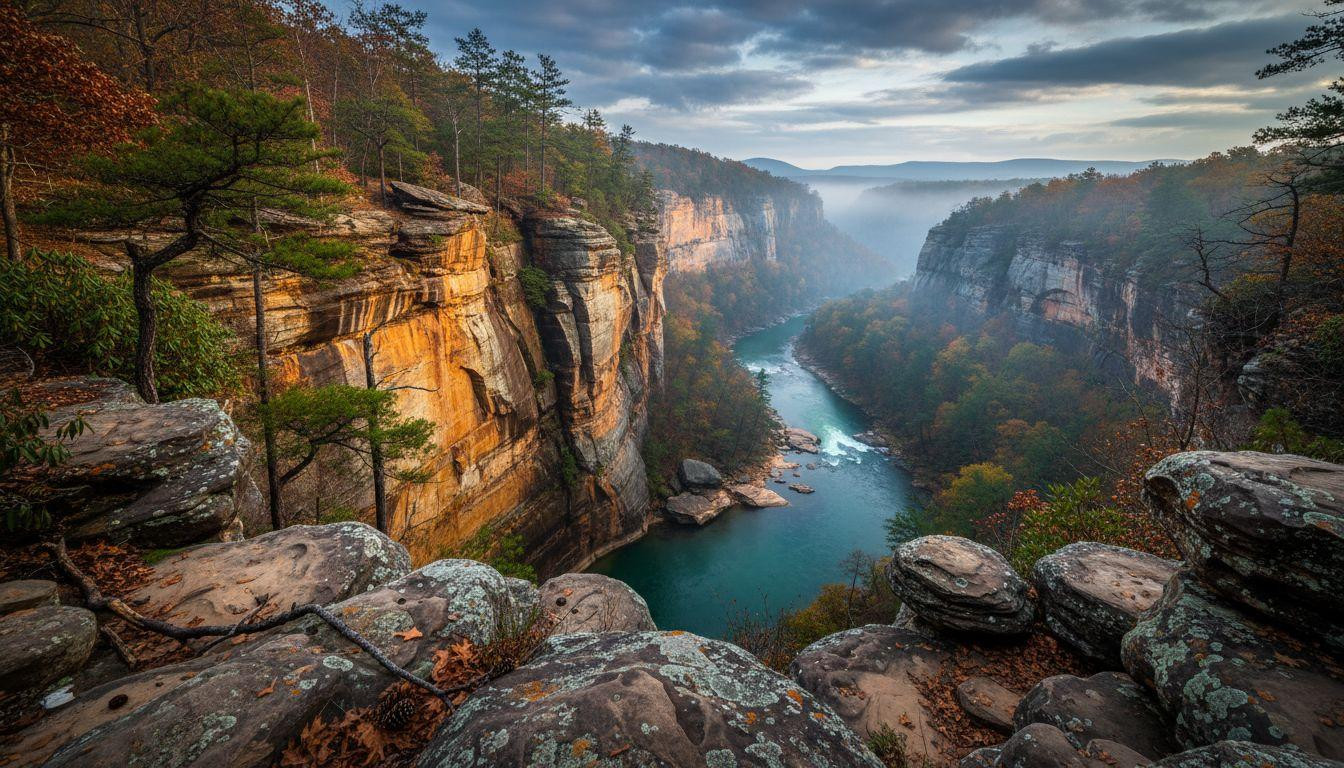Dawn breaks over Little River Canyon’s rim at 6:47 AM as November mist rises from turquoise water 600 feet below. Golden sandstone cliffs catch first light while the Little River cuts through ancient Appalachian rock in perfect silence. This isn’t the Grand Canyon drawing 6 million annual visitors.
This is Alabama’s overlooked answer: 15,288 acres of pristine wilderness where 75,000-100,000 yearly guests discover what most Americans never knew existed. The deepest canyon east of the Mississippi, Alabama’s tallest waterfall, and a National Preserve that feels like stepping back 10,000 years.
Where Alabama hides a 600-foot canyon
Little River Canyon National Preserve sits in northeast Alabama’s DeKalb and Cherokee Counties, straddling Lookout Mountain’s southwestern edge. The preserve spreads across 15,288 acres where the Little River performs a geological anomaly: flowing atop a mountain plateau before plunging into a 600-foot gorge.
Birmingham sits 90 miles southwest (2-hour drive), while Huntsville rests 55 miles west. The 11-mile Canyon Rim Parkway (Highway 176) traces the eastern edge, offering pull-off overlooks like Lynn Overlook and Hawk’s Glide where sandstone cliffs glow amber at sunset.
Unlike commercialized Western canyons, this Appalachian wonder requires no permits, charges minimal fees ($15 at Canyon Mouth Park), and welcomes visitors to hike freely among hardwood forests unchanged since Cherokee inhabitants called these mountains home.
What makes this canyon different from Grand or Zion
The river that flows on top of a mountain
The Little River creates Alabama’s only significant river-on-a-plateau system, flowing across Lookout Mountain’s 1,800-foot summit before carving this dramatic gorge. Geologists call it a “perched river”: a phenomenon rare in North America.
Where Grand Canyon’s Colorado River cuts through desert, Little River slices through dense hardwood forest. This creates a completely different visual experience: emerald canopy meeting golden sandstone, turquoise pools hidden beneath leaves. Similar Appalachian gorges like New River Gorge share this forested canyon character unknown in Western deserts.
Alabama’s tallest waterfall drops 133 feet
Grace’s High Falls plunges 133 feet through limestone formations accessible only to expert hikers willing to navigate unmarked trails. The more accessible Little River Falls drops 45 feet in a wide curtain visible from roadside overlooks, its spray catching rainbow light on sunny mornings.
Neither requires permits or advance reservations. Arrive at dawn and have them to yourself.
Walking where few Americans ever venture
Five trails from easy strolls to expert scrambles
The Path to Learning Trail offers wheelchair-accessible nature education near the visitor center. Martha’s Falls Trail (moderate, 2.4 miles) leads to seasonal cascades through rhododendron thickets.
For serious hikers, Eberhart Point Trail and Wolf Creek Trail demand technical skill. The latter drops 600 feet to river level where whitewater kayakers navigate Class VI rapids visible only from canyon floor. Eastern river canyons like Pennsylvania’s Lehigh Gorge offer similar dramatic water-carved landscapes.
Swimming holes and natural rock formations
Little Falls creates natural swimming pools where sandstone shelves form perfect ledges for careful entry into cool, clear water. Beaver Pond offers calmer wading opportunities.
The Mushroom Rock boulder field near Canyon Mouth Park displays house-sized sandstone formations weathered into impossible shapes: geological artwork 20,000 years in the making.
The quiet that Western canyons lost decades ago
Stand at Lynn Overlook on a November weekday and count the people: often zero. Summer weekends bring moderate crowds (perhaps 30 vehicles in the main parking area), but nothing resembling Grand Canyon’s traffic jams or Zion’s permit lotteries.
The canyon preserves what Western parks commercialized away: genuine solitude, unmanicured wilderness, the sense of discovery. According to regional tourism boards, visitors consistently praise the preserve’s “quiet dignity” and “underrated status” for travelers seeking laid-back Appalachian nature escapes.
That earned solitude, combined with $70-100 nightly accommodations in nearby Fort Payne, makes this Alabama’s best-kept natural secret. Like Tasmania’s endless Ninety Mile Beach, vast uncrowded landscapes still exist for those willing to venture beyond the obvious.
Your questions about Little River Canyon answered
When should I visit to avoid crowds and see the best colors?
Fall (October-November) delivers peak foliage color across hardwood forests and comfortable 55-75°F temperatures with minimal crowds. Spring (March-May) brings wildflowers and moderate weather. Summer weekends see the most visitors, especially at Little River Falls where parking fills by mid-morning.
Weekdays remain quiet year-round. November offers exceptional solitude with daytime highs of 55-65°F.
What does a 3-day trip actually cost?
Budget $210-450 total: accommodations ($70-150/night in Fort Payne motels or nearby cabins), meals ($10-20 per person at local diners serving Southern barbecue and catfish), preserve access (mostly free; $15 Canyon Mouth Park day-use fee), and gas (minimal for the 11-mile rim drive).
No permits, no reservations, no commercial tour requirements. Similar overlooked American destinations offer comparable value without Western park premium pricing.
How does this compare to Grand Canyon or Zion?
Little River Canyon offers 1/60th the visitors, zero permit requirements, immediate access to overlooks and trails, and dramatically lower costs. You trade iconic desert vistas for intimate Appalachian wilderness: dense forests, hidden waterfalls, and the satisfaction of discovering what 300 million Americans somehow missed.
Recent visitor surveys consistently rate the preserve’s accessibility and authenticity above crowded Western alternatives.
Twilight settles over the canyon rim at 5:15 PM as shadows stretch long across sandstone cliffs. The Little River catches final amber light 600 feet below while November air carries the scent of pine and damp leaves. Silence. Just the distant rush of falls and the soft call of a canyon wren echoing through Alabama’s forgotten gorge.
